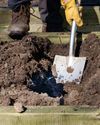
The lawn area is often the largest single feature in a garden and it acts to complement the colorful beds and borders, giving the eye of the viewer a rest, but also linking different elements together in the way a carpet acts indoors. It provides an open space for play and relaxation but, perhaps more importantly, a healthy lawn of 232 square metres of lawn (just smaller in area than a tennis court) produces enough oxygen on its own to meet the daily requirements of a family of four, according to the Lawn Institute.
Repairing a tired and damaged lawn
During the summer, constant use plus the environmental stress of periods of hot, dry or even wet weather can leave a lawn looking tired and damaged by autumn, so now is the ideal time to do some repairs. The soil at this time of year is usually moist, but not too wet, and is still warm below ground. This allows any repairs to recover quickly, as the grass-roots will continue to grow as long as the soil is at least 5°C, even though the leaves appear to have stopped growing.
This story is from the November 20, 2021 edition of Amateur Gardening.
Start your 7-day Magzter GOLD free trial to access thousands of curated premium stories, and 8,500+ magazines and newspapers.
Already a subscriber ? Sign In
This story is from the November 20, 2021 edition of Amateur Gardening.
Start your 7-day Magzter GOLD free trial to access thousands of curated premium stories, and 8,500+ magazines and newspapers.
Already a subscriber? Sign In

To dig or not to dig?
Should we be carrying out a full dig on plots now? Bob considers the pros and cons of the 'autumn dig' debate

The box ball blues
As if his beleaguered box hadn't already taken a beating, Toby now has to deal with some hungry box caterpillars

Save your own seeds
Masterclass on: seed saving

Strange sightings
Three unusual insects turn up in Val's garden in one day

A bolt from the blue!
Cornflowers are perfect for garden and vase

Winter moth prevention
Ruth shows you how to avoid maggoty tree fruits

Create a winter container
There are as many options as in summer

Lightweight gardening tools
AS well as being good for our mental health, gardening is also great exercise.

Autumn price round-up
AG finds better bargains in lesser-known brands

Rudbeckias
Rudbeckias are ideal for sunny summer patios and borders, with some able to survive our coldest winters